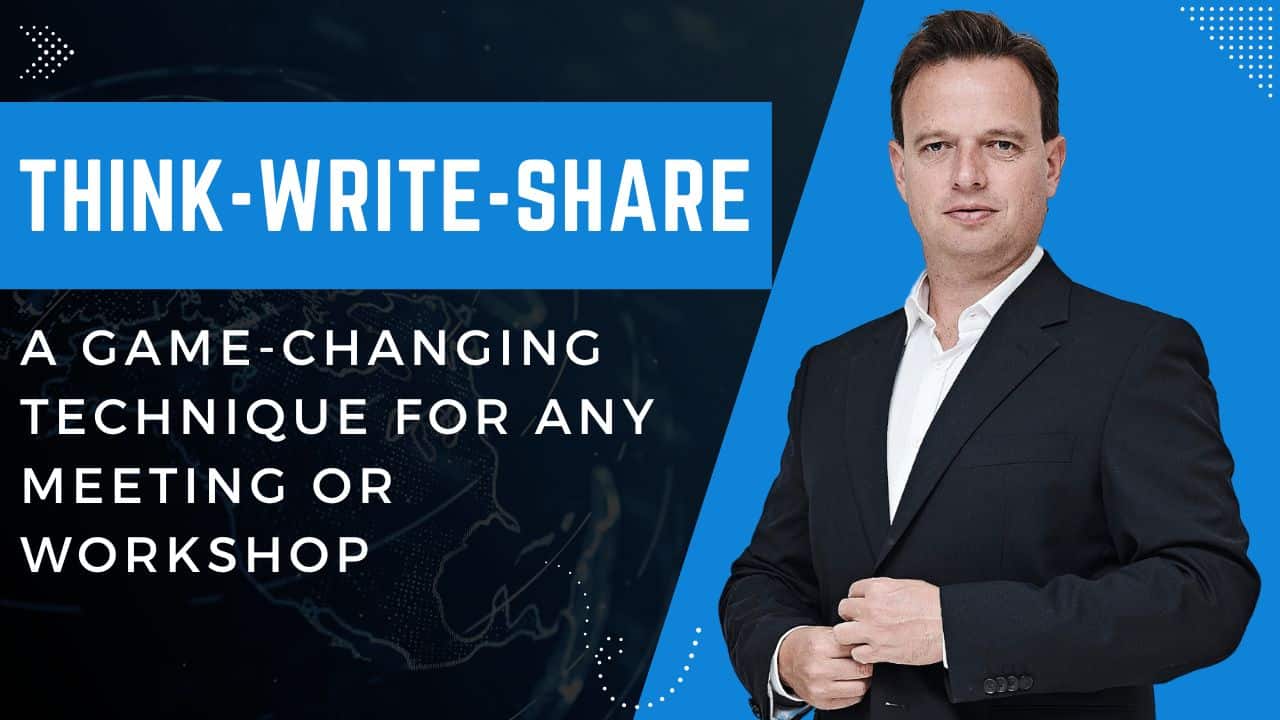In today’s issue, I’m going to show you a simple technique you can use to turbocharge any meeting or workshop.
If you use this technique, you’ll surface the best ideas your group has to offer and give everyone the opportunity to be heard.
As a general rule, meetings suck. They’re time-consuming, unproductive, boring, and stressful. And there are way too many of them.
Unfortunately, most people don’t have an easy-peasy system to help them.
Great ideas don’t happen by chance. They need to be encouraged to happen with a carefully architected process.
The process you’re going to learn today is called “Think-Write-Share” and was developed by a team of Army cognitive psychologists and neuroscientists.
The benefits of this process are:
- It’s dead simple to understand and use.
- You don’t need any special skills or preparation.
- Everyone in the room is likely to feel satisfied and listened to.
- You’ll show off your leadership skills by teaching others how to do it.
Here’s how it works, step-by-step:
Step 1: Think
- At the start of the meeting or workshop, you pose the problem or question you are all there to solve and fill in any details if asked.
- The first thing you do is invite your group to THINK about the question in silence.
- If it’s a simple problem, give them a minimum of 1 minute.
- If it’s really complex, then up to 30 minutes is appropriate.
Step 2: Write
- Next, you invite your group to WRITE their answers down. Again, in silence.
- They should write on paper with a pen. Or by typing and then printing.
- My preference is to use Post-it notes as they’re portable and you can easily move them around later.
Step 3: Share
- Next, you invite each person in the room to SHARE their answers with the group one by one.
Why it works so well?
It looks really simple and basic, doesn’t it?
You might be thinking: So what?
This process is actually based on a lot of very serious neuroscience. A team of army cognitive psychologists and neuroscientists developed it.
I’ll unpack it for you as it has some important principles.
What does the Think step do?
Step 1 prevents conscious or unconscious group thinking from taking over.
If you and a bunch of others were all in a room together, and I was a throw-out a question, and Sarah, for example, answered that question.
Everyone after that would then respond to Sarah’s answer in one way or another. Either consciously or unconsciously.
Some would be saying to themselves:
Sarah is brilliant. I agree completely with Sarah’s answer, and when it comes to my turn to speak, I’m going to say, “Yes what Sarah said. She’s dead right.”
And some would react negatively and play devils advocate by saying:
“I disagree with what Sarah said. I think she’s wrong and here's why...”
And maybe they’re thinking for themselves a little more in that instance, but they’re still thinking about the problem in the frame Sarah created.
That’s how we work. Humans are inherently lazy animals, and if there’s an opportunity to take a shortcut, we’ll take it.
Human beings are problem-solvers
And that bodes well for our ability to engage in critical thinking.
But it’s bad in the sense that we like to rush to solve problems to get them out of the way.
Often before we even understand the problem properly.
So if I were to pose you a complex problem, you would naturally start to try and solve the problem before you fully understood it.
Write has 2 reasons behind it
If you write your answer down you own that. You commit to it before you hear what anyone else has to say.
And that’s a powerful thing.
But the other thing that writing does, and this is where neuroscience kicks in, is that writing your answer down engages the cognitive parts of your brain more strongly than if you were only vocalising your answer.
This has been well tested. Experiments have been done where people in brain-scanning machines have been asked similar questions, and they’ve had them answer verbally vs writing it down first.
They can see those parts of the brain that deal with critical thinking fire more strongly when people write their answers down first.
That’s why Write is the second step.
The final step is to Share your answer
We do this person by person because none of us is smart as all of us and the best idea can’t win if no one ever hears it.
By using this technique, Think-Write-Share, you generate a larger spectrum of ideas than before and allow everyone to be heard.
The beauty is it can be used alongside any workshop tool or process you’re looking to run.
Or even in just bog standard, round table meetings.
You’ll be surprised by how effective it is in surfacing the best ideas your group has to offer.
Give it a try in the next meeting you manage and watch the magic unfold.
Well, that’s it for now.
I hope you enjoyed it and see you next week.

